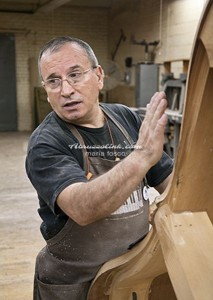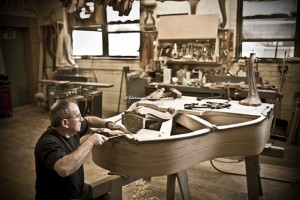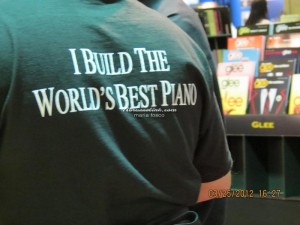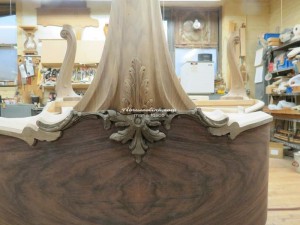Sante Auriti, Abruzzo’s “Piano Man”
In 1979, when Sante Auriti arrived in New York, he never, in his wildest dreams, would have believed that thirty years later, he would be building a grand piano behind the window of one of the most famous buildings in New York City: the iconic Steinway Hall on West 57th Street off Fifth Avenue. Nor did he realize that he would be become a press sensation in New York and around the world and that crowds would gather in front of the window for hours to watch him master his craft. For two weeks, every newspaper, news programs, electronic media and photographers picked up this story as it went viral around the world talking of the “Piano Man” who demonstrated case making a grand piano in the window of the Steinway Hall. He was such a hit, that a photograph of him working behind the window would be in the New York Times as the “Picture of the Week”.
Sante Auriti was born on the outskirts of the small artisan town of Guardiagrele in the Province of Chieti in Abruzzo. His childhood was spent herding sheep, helping his family farm the land they worked on and eventually driving a motored plow that would make him extra money helping other farmers. In the shadow of the Maiella Mountain, he developed his eagerness to learn many skills, have patience and acquire an eye for details. His family had moved to the nearby town, Orsogna while he was a child and eventually bought land there. In order to help relieve his family of their debt, he headed to Germany to work in the textile industry where 12 hour days were the norm.
He returned to Italy to serve in the military and afterwards tried to make a living in Abruzzo, but the economic situation during the ‘70’s was not the best, so he returned to Germany hoping for a better life.
In 1979, an opportunity to come to America presented itself. At first, he took whatever job he could find, but through the Orsognese community in New York where he had settled, he was urged to apply for a job at Steinway & Sons. Steinway & Sons is the world famous piano manufacturers whose factory is located in Astoria, New York and where many Orsognesi worked.
Steinway & Sons was founded on March 5, 1853 by German immigrant Henry Engelhard Steinway in New York City. He was a master cabinet maker who built his first piano in the kitchen of his home in Germany. Over the next thirty years, Henry and his sons developed the modern piano. Many of these late nineteenth centuries’ inventions were based on emerging scientific research including the acoustical theories of the renowned physicist Hermann von Helmholtz. Steinway’s revolutionary designs and superior workmanship began receiving national recognition almost immediately and finally gaining international recognition in 1867 at the Paris Exhibition when it was awarded the prestigious “Grand Gold Medal of Honor” for excellence in manufacturing and engineering. As the business expanded in New York City, the family moved their company to Astoria, a German community in Queens, New York just across the river and developed “Steinway Village”, a virtual town for all its employees. It also opened a factory in Hamburg, Germany. Steinway & Sons continue to this day, to hand craft its piano at its Astoria, New York and Hamburg, Germany factories using many of the same techniques developed by the Steinway family.
Sante began working as an entry-level employee on May 14, 1979. He did whatever work he was given. Sweeping, cleaning up after workers, substituting for absent employees, but always watching closely what others were doing. He began observing. He had an eye for details. He would be asked over and over again if he could do a few things in different departments. One thing led to another and one department job lead to working in another department job. He began to learn the different aspects of piano making. He was learning quickly and with a passion. He volunteered to learn new techniques and picked up new skills. He learned of the year-long process of building a piano. His supervisors also took notice of his quick ability to learn and have an eye for the art of building a piano.
After about ten years, he was finally approached by his supervisor. He was asked if he wanted to learn how to work on the most special pianos, the Louis XV and the Chippendales. He would learn from the master craftsman in the casemaking department.
After a decade of learning, he would bring all his passion and artistry to life and became himself the master casemaker at Steinway & Sons. A coveted title to the iconic brand. He not only would be the casemaker of finishing of the Louis XV and Chippendales grands, but of all lines of Steinway & Sons ebony grand pianos. He has probably worked on every grand piano that has left the factory in the last thirty-six years.
Over the years, his pure joy is his work. He loves to talk about it. He demonstrates his craft on tours. He has traveled to Chicago to speak about it. He has given demonstrations at malls. He even built a piano at a Music Teachers Conference. He loves when people and groups who tour the factory stop by his work room to see him and ask about his craft. He enjoys showing everyone the process first-hand. He gives in-depth demonstrations and always gives a parting gift such as a small piece of wood that he was working on. He has given hundreds of interviews over the years and the one thing he always says is that he loves his job. He is passionate about his craft and creating a piece of artwork. There is no better satisfaction than building an instrument that brings beauty into the world. He has been labeled by the media as the “other” Piano Man.
Very few artisans are left in the world. Steinway & Sons is still one of the only few companies that uses craftsmanship to build their pianos. Sante feels he is very lucky to be part of such a process. He also feels that he brings a touch of Abruzzo in his soul every day in the factory. Although, he was not raised to be a craftsman, he was born in Guardiagrele, an Abruzzese town historically renowned for centuries for its artisans and craftsmanship. Through fate, he is continuing the cultural legacy of his native town, Guardiagrele.










